He is the eight president of the Clark Development Corporation (CDC). And comes April, as the CDC celebrates its 16th anniversary, President and CEO Benigno Ricafort likewise celebrates his eight month as head of the freeport zone. He was also appointed on the eight month of the year 2008. Coincidence? Luck? A good omen? Name it. But Ricafort is a person who seems to be enchanted with superstitions although he is wise enough not to depend on his beliefs alone.
He always says “I am not here to undo what my predecessors have done.” He said he is at the CDC to get things done. And true enough, the government-owned corporation continues to grow despite the current global meltdown. Clark’s active locators are recorded at 434 with commitments of new capital investments of P36.51 billion. Meanwhile, current investment have already reached P68.63 billion generated from industrial, garments manufacturing, tourism, IT and electronics, and Business Process Outsourcing industries.
Resiliency, determination and passion will best describe Clark Freeport Zone today under the stewardship of Ricafort.
Ricafort’s strategy of involving key personalities and groups in the community, particularly the private sector, is working well for the refocused development at the freeport zone. The new CDC leadership is maximizing its resources and efforts in developing the 10,000-hectare sub-zone now named as the Next Frontier.
In the next few years, CDC is eyeing major development in tourism, light industries and institutional investments at the Next Frontier. The projected yield from such investments is pegged at P144.78 billion and is expected to create about 47,000 jobs.
The only challenge to CDC is how to address the social costs brought by the planned developments. I learned that the existing Aeta communities, about 10 of them, will be redesigned by the management into two large communities with full amenities, service facilities like hospitals, schools and local government offices. I wish CDC the best in this endeavor because we all know that the hardest part of development is the initial phase where you encounter a lot of opposition. Once you’ve got over it, growth is inevitable.
Given its proximity to the Subic Clark Tarlac Expressway and its low 5 percent tax rate to investors, Clark Freeport Zone has the biggest edge against other industrial zones in the country. From NEDA;s projections, Central Luzon’s population will probably increase by 5 million in the next 10 years. This is mainly due to economic activities in the area, particularly at the Clark Freeport Zone.
More and more sunshine industries are likewise seen to put up within Clark’s perimeter complementing the progress inside the Freeport zone. This is not withstanding the parallel developments at the Diosdado Macapagal International Airport (DMIA).
Learning these anticipated scenarios, Ricafort is genius enough to accept proposals and recommendations from active private sector groups like ADCL, Pampanga Chamber of Commerce and Metro Angeles Chamber of Commerce and Industry.
In the latest meeting at the Metro Clark Advisory Council (MCAC) in Capas, Tarlac, ADCL President Renato S. Tayag Jr. formally presented the concept paper for the need to establish a bulk water system at the sub-zone in anticipation of the growing demand on water within the metro Clark area.
This is team play at its best. You have a government entity focused on its mandate and a very participatory private sector working in tandem with the bureaucracy for the overall welfare of the citizens.
This is exactly what Ricafort is talking about — the private-public sector partnership that will bring CDC into greater heights, thus providing more income for the government, more jobs for the people and more opportunities for the investors.
He always says “I am not here to undo what my predecessors have done.” He said he is at the CDC to get things done. And true enough, the government-owned corporation continues to grow despite the current global meltdown. Clark’s active locators are recorded at 434 with commitments of new capital investments of P36.51 billion. Meanwhile, current investment have already reached P68.63 billion generated from industrial, garments manufacturing, tourism, IT and electronics, and Business Process Outsourcing industries.
Resiliency, determination and passion will best describe Clark Freeport Zone today under the stewardship of Ricafort.
Ricafort’s strategy of involving key personalities and groups in the community, particularly the private sector, is working well for the refocused development at the freeport zone. The new CDC leadership is maximizing its resources and efforts in developing the 10,000-hectare sub-zone now named as the Next Frontier.
In the next few years, CDC is eyeing major development in tourism, light industries and institutional investments at the Next Frontier. The projected yield from such investments is pegged at P144.78 billion and is expected to create about 47,000 jobs.
The only challenge to CDC is how to address the social costs brought by the planned developments. I learned that the existing Aeta communities, about 10 of them, will be redesigned by the management into two large communities with full amenities, service facilities like hospitals, schools and local government offices. I wish CDC the best in this endeavor because we all know that the hardest part of development is the initial phase where you encounter a lot of opposition. Once you’ve got over it, growth is inevitable.
Given its proximity to the Subic Clark Tarlac Expressway and its low 5 percent tax rate to investors, Clark Freeport Zone has the biggest edge against other industrial zones in the country. From NEDA;s projections, Central Luzon’s population will probably increase by 5 million in the next 10 years. This is mainly due to economic activities in the area, particularly at the Clark Freeport Zone.
More and more sunshine industries are likewise seen to put up within Clark’s perimeter complementing the progress inside the Freeport zone. This is not withstanding the parallel developments at the Diosdado Macapagal International Airport (DMIA).
Learning these anticipated scenarios, Ricafort is genius enough to accept proposals and recommendations from active private sector groups like ADCL, Pampanga Chamber of Commerce and Metro Angeles Chamber of Commerce and Industry.
In the latest meeting at the Metro Clark Advisory Council (MCAC) in Capas, Tarlac, ADCL President Renato S. Tayag Jr. formally presented the concept paper for the need to establish a bulk water system at the sub-zone in anticipation of the growing demand on water within the metro Clark area.
This is team play at its best. You have a government entity focused on its mandate and a very participatory private sector working in tandem with the bureaucracy for the overall welfare of the citizens.
This is exactly what Ricafort is talking about — the private-public sector partnership that will bring CDC into greater heights, thus providing more income for the government, more jobs for the people and more opportunities for the investors.




